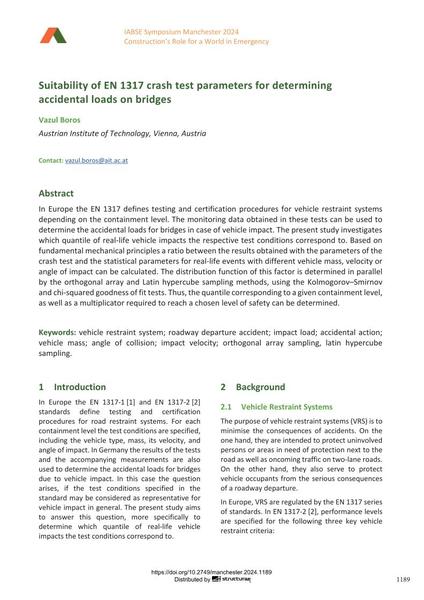Suitability of EN 1317 crash test parameters for determining accidental loads on bridges

|
|
|||||||||||
Bibliographic Details
| Author(s): |
Vazul Boros
(Austrian Institute of Technology, Vienna, Austria)
|
||||
|---|---|---|---|---|---|
| Medium: | conference paper | ||||
| Language(s): | English | ||||
| Conference: | IABSE Symposium: Construction’s Role for a World in Emergency, Manchester, United Kingdom, 10-14 April 2024 | ||||
| Published in: | IABSE Symposium Manchester 2024 | ||||
|
|||||
| Page(s): | 1189-1197 | ||||
| Total no. of pages: | 9 | ||||
| DOI: | 10.2749/manchester.2024.1189 | ||||
| Abstract: |
In Europe the EN 1317 defines testing and certification procedures for vehicle restraint systems depending on the containment level. The monitoring data obtained in these tests can be used to determine the accidental loads for bridges in case of vehicle impact. The present study investigates which quantile of real-life vehicle impacts the respective test conditions correspond to. Based on fundamental mechanical principles a ratio between the results obtained with the parameters of the crash test and the statistical parameters for real-life events with different vehicle mass, velocity or angle of impact can be calculated. The distribution function of this factor is determined in parallel by the orthogonal array and Latin hypercube sampling methods, using the Kolmogorov–Smirnov and chi-squared goodness of fit tests. Thus, the quantile corresponding to a given containment level, as well as a multiplicator required to reach a chosen level of safety can be determined. |
||||
| Keywords: |
impact velocity impact load vehicle restraint system Latin hypercube sampling accidental action roadway departure accident vehicle mass angle of collision orthogonal array sampling
|
||||
